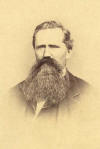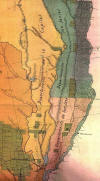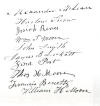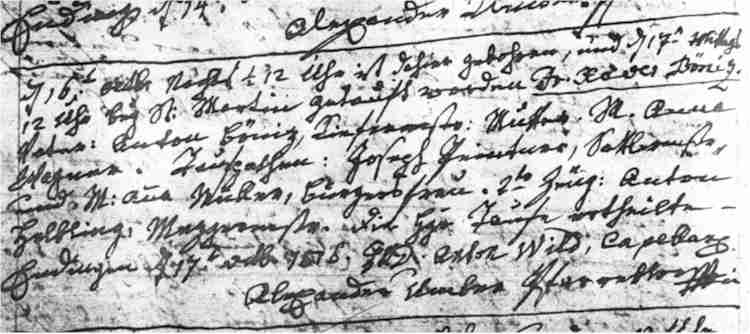 |
Franz Xaver Benitz | Page last modified: |

Francis X. Benitz
Feb.12, 1866
San Francisco
California, USA
(Source: John C. Benitz,
J.K.Benitz collection)
He was born Franz Xaver Böniz on 16 October, 1816, in Endingen-im-Breisgau, Grand Duchy of Baden, Germany, the youngest son of Anton Böniz (master cooper) and Maria Anna Wagner.
He was baptised Franz Xaver Böniz. In the US census of 1850 he is listed as Francis Bonits. In the 1860 census he is listed twice: as F. Bennitz (merchant) at Fort Ross, and Francis Bennett (grocer) in Cleveland. In 1863, he signed a letter to Thadeus, his brother in Germany, as F.X. Benitz. His brother, Wilhelm, in his letters to Thadeus always refered to him as Xaver. In 1866, in documents establishing the Colonia California he is identified as Francisco Benitz but signs himself Francis Benettz. He is identified as Francis Benitz in his sister-in-law’s (Josephine - wife of Wilhelm) photograph albums. During the 1870’s, Wilhelm’s children knew him as Uncle Frank.
On this website we refer to him by his given German name Franz, to differentiate him from the many Franks who were named directly and indirectly in his honor. However, in English he apparently prefered Francis. For the sake of consistentcy, we refer to his wife by her given German name Alexandrina though in English she appears to have favored Alexandrine.
We're not sure exactly when Franz emigrated to North America, but he could have accompanied his brother Anton during or before 1837. He first settled in Pittsburgh, Pennsylvania, where in 1837 he married Alexandrina Josephine Seeger (or Seiger) from Sutthausen, Hanover, Germany [Sutthausen lies just south of Osnabrück in today’s Lower Saxony, west of Hanover]. According to her family, Alexandrina left home at age 19 in August of 1837 and, with 450 Reichstaler ($13,400 US-2000) to her name, emigrated to the US.
In 1860-1863, Franz was sued for unpaid debts. The summary of the case in the “Annals of Cleveland” provides the following details. Apparently Franz was not a good businessman.
“Francis and Alexandrina Benitz were married in 1837 and made their home in Pittsburgh, Pennsylvania, where they lived for 4 years. Mrs. Benitz, who had a dowry of $500 [$15,000 US-2000] before her marriage, received $200 [$6,000 US-2000] more from her father in Germany. She permitted her husband to invest the money in business and it was lost.
“In 1841 the couple and a daughter, Amelia, moved to Cleveland and on December 25, 1843 Benitz in his own name entered into a contract with Levi Johnson for the purchase of 25 feet of land off the west side of sublot 76, fronting on the north side of Federal Street (now St. Clair Avenue). The parcel was part of a subdivision of original two-acre lots 178 to l8l and 187 to 190. Benitz paid $10 [$300 US-2000] his own money on the contract.
“Mrs. Benitz' father died in Germany, and on September 28, 1846 Mrs. Benitz received $285 [$8,600 US-2000] from his estate.
“The couple later built a house and grocery store on their lot. Benitz stated that the building cost about $300 [$9,000 US-2000] and was paid for with his wife’s money.
“For twenty years, from about 1841 to 1860, Franz and Alexandrina lived at 277 St. Clair Street where they also ran a grocery store. They had three children, Amelia (1840, Pittsburgh), Elizabeth (1843, Cleveland), and William (1845, Cleveland).”
In 1860, or shortly before, Franz left the store in Alexandrina’s care to join his brother Wilhelm at Fort Ross in California. He was at Fort Ross at the time of the 1860 census. However, he is listed in the Cleveland directory of 1861 (as Bennett, Frank) and in the directory of 1861-1862 (as Bentz, Francis) - which suggests Alexandrina may have expected him to return from California. In 1860 through 1863, per the Annals of Cleveland, they were defendants - along with daughter Amelia and husband - in a case filed by creditors.
Alexandrina apparently continued to run the grocery store long after Franz left. It is listed in her name in the directory of 1863-1864 (as Benitz, Alexander), then is missing until 1867 when it reappears in her name (as Benitz, Alexandrine) with a home address of 701 St. Clair Street. However, she died at her original home address, 277 St. Clair Street, at age 68 on April 3, 1888. Funeral services were held the next day at St. Peter’s Church.
Intriguingly, Benitz, Francis is listed as a cooper (the family trade in Germany) in the Cleveland directory of 1864-1865, living at 294 Lake Street - a parallel street near St. Clair Street. This listing indicates he may have returned to Ohio, but why was he not living with Alexandrina at the grocery store address? Our guess: Alexandrina had had enough of him. Anyway, he didn't stay long because by February of 1866 he is back in California. A few months later, July, he is in Argentina.
In the 1860 census, F. Bennitz is listed as a 43 year-old merchant residing at Fort Ross, California. In a letter to his brother, Thaddaeus in Germany, dated 15 January, 1863, he had been living and working there for a while and hoped his family would join him. His son, William, was already there with him. In the same census of 1860, immediately below F. Bennitz, Wm. Bennitz is listed as a 13 year-old cook. Franz’s second daughter and her husband, Elizabeth and William McNamara, moved to California in about 1863 but returned to Ohio in 1867. Alexandrina apparently never left Cleveland.
We're not sure how Franz made his living in California during those years. Per his letter, he apparently lived at Fort Ross and assisted Wilhelm with the fort’s operation. That he was a respected member of the Salt Point precinct (which included Fort Ross) is evident by his performance as a de facto officer (inspector) in a local election.
Wilhelm's intent to sell Fort Ross likely prompted Francis to join a group from Santa Rosa (Sonoma county, California) who were emigrating to Chile.
[Note: Most of the information and documents included in this section were very kindly provided by Javier Maffucci-Moore, g-g-grandson of William Tandy Moore, “military” leader of Colonia California. Please read his e-mails.]

Section of Santa Fé Colonies of 1886
From: “Descripción geográfica y estadística de la provincia de Santa Fe”,
por Gabriel Carrasco,
4a. ed., Stiller & Laas,
Buenos Aires, 1886.
(Source: J. Mafucci-Moore)

Signatures of the
10 North Americans
on the petition of
July 20, 1866
(#9: Francis Benettz)
(Source: J. Mafucci-Moore)

Painting by
F. Benitz, 1868
(on Reynolds's Bristol Board)
We believe it is of Colonia California
by Franz X. Bz.
(Source: P. Benitz / Ucko Collection)
On 10 Feb. 1866, Franz sailed from San Francisco on the ship “Golden Age”, bound for Panama. From there, he probably sailed to New York, then Buenos Aires. He was joining a group of Californians from Sonoma County led by William Tandy Moore who were settling in Argentina. The group had left earlier, during the last months of 1865.
Moore was a southern sympathiser who was dissatisfied with the Civil War and the reconstruction period that followed. According to some reports he and his group went in search of gold, however, they took with them farming equipment (plows, thrashers). They sailed to Chile, but learning of the pampas of Argentina, they didn't remain long. They crossed the Andes by mule to Mendoza, then travelled east to Rosario in galera (stage-coach pulled by six mounted horses), then north by river boat up the Paraná River to Santa Fé city where they called upon the provincial governor. They turned down the first land offered, on Río del Rey 250-300 km. to the north, and selected lands closer to civilization, part of the Indian reducción (reservation) of San Javier.
On July 20, 1866, ten settlers petitioned for 4 square leagues of fiscal land (10,799 ha. / 26,686 ac.), the northern quarter of the reservation, one league along the river, 4 deep. Francisco Benitz was one of the ten settlers who signed the purchase document. On August 2, 1866, they paid cash down 1,696.60 pesos fuertes, their title signed by governor Nicasio Orońo [Approx. $50,440 US$-2000 - or $4.67 per ha., $1.89 per ac.].
They named their settlement Colonia California, and elected Alexander McLean as their director (the colony’s civilian leader & representative) and William T. Moore as their "military" leader - he assumed the title of Captain. The Californians were the first group to arrive in the area known as Pájaro Blanco, followed by the Welsh in 1867, the French in 1869 (Colonia Eloisa), and the British in 1870 (Colonia Alejandra). Colonia Alejandra became the most important and was later mainly inhabited by valdenses (northern Italians).
Though Colonia California was productive agriculturally (cattle & corn did well) and the settlers prospered, they suffered from continued depredations by the Indians. Captain Moore became famous as an Indian fighter but in the end, because of the Indians, the colony failed.
Franz sold out in 1871 to Robert Wasp. Captain Moore lost his eldest son to an Indian raid in 1875 and eventually returned to the US in 1877 - many of the settlers returned with him. One son decided to remain, Moses Thomas "Tom" Moore. He, and likely the other remaining settlers, sold out and bought land near the British colony of Alejandra (90 km. farther north on the San Javier river). Tom bought land to the west of Alejandra and became a wealthy estanciero (rancher).
For a very interesting account from the viewpoint of a (then) young American, read The Life of William T. Moore, by Francis Vogel, privately printed in New York, 1946. See also the e-mails we have exchanged with Javier. There are contemporary newspaper articles in an English language newspaper published in Buenos Aires. And more recently, on the 100th anniversary of the founding of the colony, several articles were published in local newspapers (El Litoral: 18 Sept. 1966, 19 July 1986, 13 May 1988; La Nación: 20 Sept. 1966].
Other colonias: Confusingly Franz’s nephew, Franz (Frank) Joseph Benitz - eldest son of Wilhelm, a few years later invested in the Colonia Espín in northern Santa Fé, 30 km. west of Alejandra and about 90 km. north of Colonia California (see map above).
We don't know where Franz travelled after selling his share of Colonia California in 1871, but on July, 21, 1873, he reappears in Oakland, California. His stories about the fertile Argentine pampas convinced his brother Wilhelm to emigrate once again. Wilhelm and his family eventually departed Oakland a year later, in July, 1874, travelling by sea down to Panama, then up to New York. According to Alfred’s diaries, in August, 1874, Franz rejoined Wilhelm and his family in New York. Alfred does not say so, but it is likely Franz travelled overland from California to New York, probably with the intention of visiting his family in Ohio. From New York, they crossed the Atlantic to Southampton (UK), then sailed its length to Buenos Aires, finally arriving in Argentina on October 9, 1874.
Franz helped them establish their new home at estancia "La California", a few kilometers south of present day Las Rosas, Santa Fé (a much more fertile area than San Javier). Wilhelm died in 1876 and Franz likely assumed a paternal role with Wilhelm’s young brood. He was remembered fondly as Uncle Frank by them and lived and worked at the estancia for the remaining years of his life. Uncle Frank died on 14 October, 1880, and was buried in the family cemetery on the estancia (Note: The records of the Episcal Church in Rosario/SFé have been transcribed and are available on line. Franz's funeral record states he “died on the estancia of a carbuncle”. Note that (i) “a carbuncle” implies a large contagious, difficult to cure, boil or abscess; however, (ii) “carbuncle” alone (without “a”) is anthrax, a contagious disease of livestock, infectious to humans, often fatal before the advent of antibiotics).
For a great deal more about Uncle Frank in California and Argentina during the 1860’s and 1870’s, read his nephew Alfred Benitz’s biography - California: chapters: I, III, & IV; Argentina: chapters X through XIII.
Franz and Alexandrina had three children:

Franz Xaver Böniz
Church baptismal records, 1816 - Endingen, Baden, Germany
(Source: James Bell, from: LDS (Mormon) BMD records)
Nr. 90 1816
On October 16 at 11:30 at night a boy was born at this
location. He was baptized in the St. Martin’s church on October 17 at 12:00 o'clock
noon. He was named Franz Xaver Böniz. Father: Anton Böniz master
cooper. Mother: Maria Anna Wagner. Sponsors: Joseph Peintner master saddle
maker and Maria Anna Müller “Bürgersfrau” [middle-class woman]. Witness:
Anton Halbling master butcher. Endingen, October 17, 1816. Anton Wild, capellan.
Alexander Umber pastor
Estancia “La California”, north of Cańada de Gomez, October 15th, 1880,
buried on the Estancia, FRANCIS XAVIER BENITZ, born in Endigen, Baden,
Germany, October 16th, 1816, died on the Estancia of carbuncle, brother of
the late William Benitz.
J. R. Woods
Book A
Methodist Episcopal Church of Rosario, Santa Fé, Argentina.
Primera Iglesia Metodista de Rosario
Joseph R. Woods, pastor (and US Consul)
(Source: Javier L. Maffucci Moore, from: microfilmed records at:
ISEDET,
an educational institution of the
Methodist Church in Buenos Aires, Argentina)
© Peter Benitz (Benitz Family)